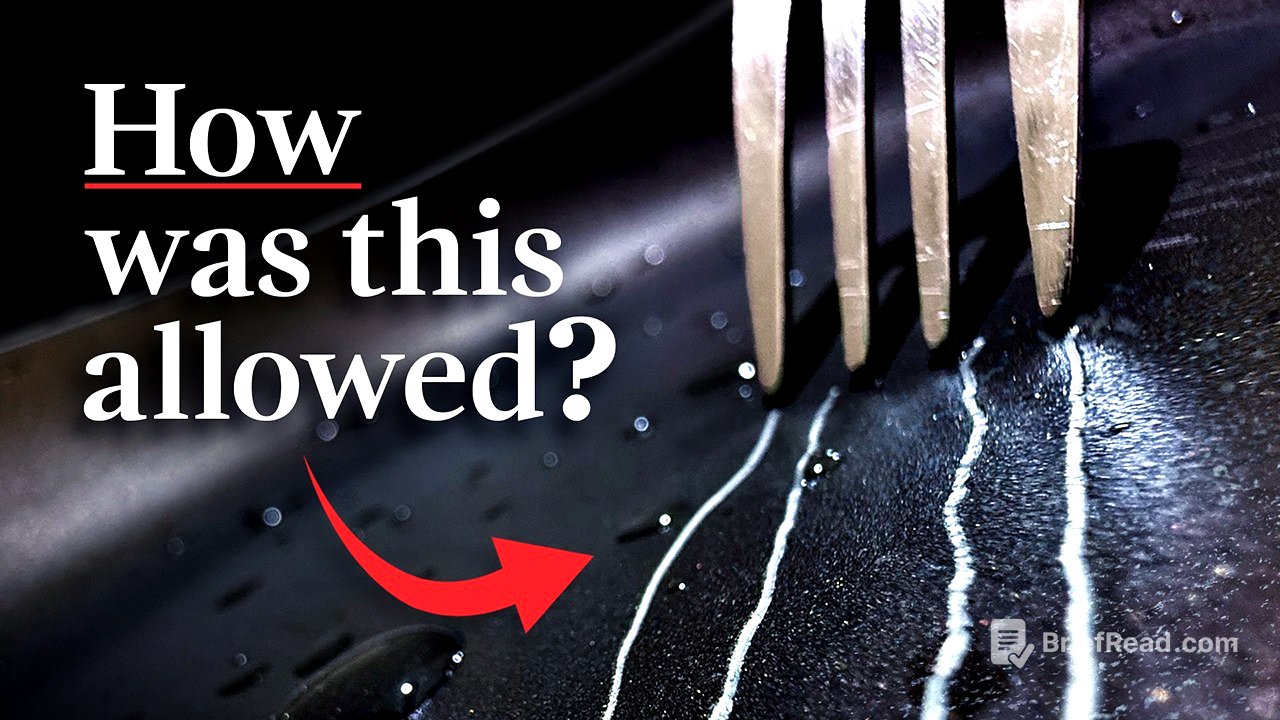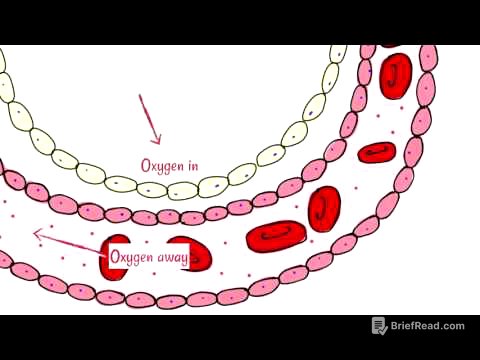TLDR;
This video investigates the history, impact, and potential solutions related to PFAS "forever chemicals". It begins with the discovery of Teflon and its widespread use, then uncovers the dark side of PFAS, including health risks, environmental contamination, and corporate cover-ups. The video also explores the sources of PFAS exposure, methods for removing them from drinking water, and individual actions to lower PFAS levels.
- The discovery of Teflon led to the widespread use of PFAS in various products.
- PFAS pose significant health risks and cause widespread environmental contamination.
- Corporations concealed the dangers of PFAS for decades.
- Exposure sources include contaminated water, food packaging, and consumer products.
- Filtration systems and industrial capture methods can remove PFAS from water.
Killed by Fridges [0:00]
In 1929 Chicago, numerous deaths occurred due to leaking methyl chloride, a toxic and odorless gas used in refrigerators. Some refrigerators used flammable gases, causing explosions. DuPont sought a safer alternative, leading to the accidental creation of Teflon, a seemingly magical substance. Teflon found its way into many products, but the chemicals used to make them were released into the environment, causing widespread contamination.
Teflon and The Manhattan Project [5:27]
Chemist Roy J. Plunkett discovered Teflon in 1936 when tetrafluoroethylene (TFE) gas polymerized into a white, slippery powder inside a cylinder. The resulting polytetrafluoroethylene was inert, resisting water, acids, bases, and solvents due to the strong carbon-fluorine bonds. DuPont, Plunkett's employer, collaborated with the US Army on the Manhattan Project, where Teflon was used to create gaskets and cylinder linings resistant to corrosive uranium hexafluoride, a gas used to enrich uranium for nuclear bombs.
Teflon is Tricky [7:59]
DuPont trademarked polytetrafluoroethylene as Teflon in 1944. During World War II, Teflon production increased to meet military demands, but its fabrication was challenging. Teflon could only be molded into solids and didn't dissolve in water, making it difficult to create a spray. Polymerizing TFE into Teflon required an initiator, but the reaction could become dangerously hot, leading to an explosion at the Arlington plant in 1944 that killed two workers.
The Teflon Revolution [11:37]
After the war, the army lifted secrecy bans on Teflon patents, allowing DuPont to sell it commercially. In 1954, Marc Gregoire, a French engineer, used Teflon on his fishing gear, inspiring his wife to suggest coating a pan, leading to the creation of non-stick cookware. Teflon, C8, and similar chemicals were used in various products, including stain-resistant carpets (Scotchgard), waterproof jackets (Gore-Tex), medical implants, and even to coat the Statue of Liberty's framework. By the late 1990s, Teflon generated about a billion dollars in yearly sales for DuPont.
Earl Tennant's Farm [13:27]
Earl Tennant, a farmer, suspected that something in a creek was poisoning his cows, which were wasting away and developing tumors. The creek was contaminated by a discharge pipe from a landfill belonging to DuPont's Washington Works, the first commercial Teflon plant. The townspeople shunned Earl and his family for investigating DuPont, which was a major employer and benefactor in Parkersburg, West Virginia.
Inside DuPont [17:34]
Rob Bilott, Earl Tennant's lawyer, requested Washington Works' operational records and discovered the chemical C8 (PFOA). DuPont's internal studies from 1961 showed that C8 caused abnormal liver growth in rats at low doses and was lethal at high doses. C8 was concerning because it was persistent, bioaccumulative, and could mimic fatty acids, potentially disrupting bodily systems. DuPont's studies indicated that C8 should be handled with extreme care and skin contact avoided.
Fluoride In Drinking Water [20:28]
In 1975, researchers studying fluoride in blood samples found organic fluorine, which didn't follow the same trend as inorganic fluoride. They discovered that 3M was producing these organic fluorides, like PFOA, but 3M initially denied it. Later, 3M confirmed their chemicals were in the blood of people across the US. DuPont found that their workers were contaminated with C8 at levels 1,000 times higher than the general population, and many showed signs of liver disease. DuPont was dumping tons of C8 into the Ohio River and landfill.
It's bigger than that [25:00]
In the early 1980s, a cancer study in rats confirmed that PFOA caused testicular tumors. DuPont collected samples around Washington Works and found C8 in the public water supply. In 1984, DuPont decided against swapping C8 for a safer chemical due to economic reasons and established a "safe" dose for drinking water at one part per billion. DuPont's own testing revealed that the landfill wastewater leaching into Earl's creek contained 1,600 parts per billion of C8, but they didn't disclose this information.
What is PFAS? [29:23]
DuPont was pressured to phase out C8 and created a spinoff company, Chemours, which began using GenX (C6), a shorter version of C8. However, studies showed GenX also caused tumors in rats. GenX is more mobile and can contaminate larger areas. C8 and GenX belong to a family of over 14,000 manmade chemicals known as PFAS (per- and polyfluoroalkyl substances). PFAS are used in various products for their liquid and grease-repellent properties, including clothing, food packaging, cosmetics, and electronics.
How much PFAS is in Derek’s blood? [35:56]
PFAS are known as "forever chemicals" due to their persistent nature in the environment, found everywhere from cities to remote wilderness areas. Companies knew about the dangers of these chemicals 50 years ago but didn't inform the public or regulators. Blood tests reveal that nearly everyone has PFAS in their blood. Long-chain fluoropolymers like Teflon are generally safe because they are too large to be absorbed into the bloodstream. However, the processing aids used to make them, such as PFOA and GenX, are dangerous.
How forever chemicals get into your blood [37:56]
The National Academies of Sciences published a comprehensive document on PFAS toxicity in 2022, focusing on seven perfluoroalkyl acids. Exposure to these acids has been linked to high cholesterol, decreased immune response, kidney cancer, and decreased growth in infants. The combined sum of these acids in Derek's blood was 17.92 parts per billion, exceeding the US median. The three main sources of PFAS exposure are PFAS-containing products, food, and water.
Removing PFAS from drinking water [46:18]
PFAS from products end up in the environment, with factories often lacking proper containment measures. Food packaged in PFAS-treated materials, such as microwave popcorn bags and fast-food wrappers, can contaminate food. Water is a significant source of exposure, especially near PFAS factories, military bases, and airports due to firefighting foams. The entire water cycle is contaminated with PFAS, including rainwater. The US EPA set legal limits for PFAS in drinking water in April 2024.
Can you lower your PFAS levels? [49:30]
PFAS-certified filters, such as reverse osmosis, granulated active carbon, and ion exchange filters, can remove PFAS from drinking water. Companies like Puraffinity are developing custom filters to capture PFAS at the source during manufacturing. Individual risk from PFAS depends on factors like water contamination and lifestyle. Prioritizing smoking cessation, exercise, a healthy diet, and sufficient sleep are more impactful for overall health. Firefighters can reduce PFAS levels by donating blood or plasma frequently. Banning PFAS in hygiene products, cosmetics, and food packaging is advisable, but complete elimination is challenging due to reliance in medical implants and semiconductor manufacturing.









